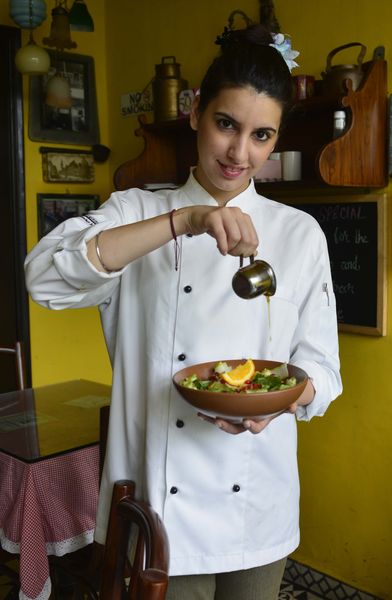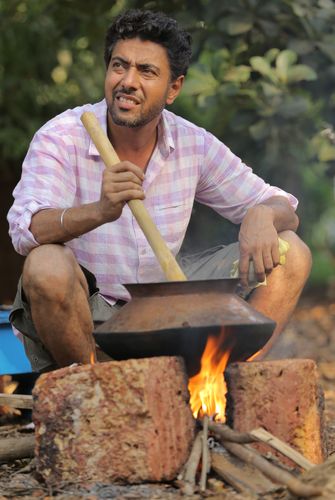Nearly five years ago, celebrity chef Anahita Dhondy had chalked out a perfect career path for herself. She went to London to pursue Grand Diplôme at Le Cordon Bleu London, one of the world’s most prestigious culinary schools. After completing the course she wanted to join an international kitchen abroad and settle there. But, a few months into the course, everything changed.
“After a while in London, I started missing my mom’s food—the Parsi food,” says Dhondy. “I started cooking for myself and for my friends. It was only then I realised how good I was with Indian food.”
Eventually, she returned to India with the dream of opening a Parsi restaurant, and conceptualised SodaBottleOpenerWala, a high-end Parsi food eatery, for restaurateur A.D. Singh. But, she was not satisfied. She realised the gaps in her learning. “So, I travelled to the interiors of Gujarat, Maharashtra and Daman,” says Dhondy, “looking for classic Parsi recipes.”
Dhondy is now working on a book on traditional recipes like Bhaji Dana Ma Gos (succulent mutton cooked with green veggies) and Dudh Na Puff (a dessert). Dhondy got the Dudh Na Puff recipe from Udvada, a coastal town near Surat. The hotel she stayed had it on the menu, but it had to be pre-ordered. Next day, when it arrived, she followed the delivery woman to her home. “She was on a bicycle and I was chasing her on foot,” says Dhondy. “She was quite confused and asked me what I wanted. When I told her my intention, she took me home and showed me the entire process.”
Dudh Na Puff is essentially milk froth. The milk is first sweetened with sugar and flavoured with cardamom, nutmeg and rosewater. Then it is beaten by hand, and the froth is collected in a glass. The froth is then served chilled in a tall glass.
 On a mission: Chef Anahita Dhondy garnishing one of her salads at SodaBottleOpenerWala cafe, Khan Market, New Delhi | Arvind Jain
On a mission: Chef Anahita Dhondy garnishing one of her salads at SodaBottleOpenerWala cafe, Khan Market, New Delhi | Arvind Jain
But, Dhondy is not an exception. Many Indian chefs are stepping out of their comfort zones and travelling across the country to revive old and lost cuisines. For instance, celebrity chef Kunal Kapur has been travelling for a year to revive the tradition of pickling. Kapur is doing a food show ‘My Yellow Table 3’ for NDTV Good Times.
He says that, over the years, food has become standardised internationally—like pasta, pizza and burger—and a lot of dishes, like pickles, are dying. “It was something that was passed on from one generation to the other,” says Kapur. “The older generation would teach the next generation how to make papad, badi and achar [pickle]. And, the whole process was a celebration that happened in homes annually.” “But, it is a tedious process,” Kapur adds. “Now, people do not want to invest so much time and energy in making pickles, because of which a number of old recipes are dying.”
For instance, he says, in Siliguri they make a pickle using chuk amilo (made of a local lemon called jamier) and black sesame seeds. In an iron wok, the lemon juice is reduced to a black glaze, this is called chuk amilo. Then, black sesame seeds are roasted and powdered. Salt, granular salt, roasted chilli crush and the sesame seed powder are added to the glaze. The pickle is granular and sticky, and it tastes nutty and sour.
Some of the pickle recipes that he stumbled upon are so old that collecting the ingredients became a task in itself. “The Pradhan family [in Darjeeling] took out their late mother’s recipe book, and we decided to make pickle of bhakin amilo,” says Kapur. Bhakin amilo is a fern that has small seeds that are sour. They smell like fennel.
“But, when a member of the Pradhan family and I set out to buy the ingredients, some of them were not available,” says Kapur. “The vegetable vendor started laughing and mocked us saying ‘Which era’s stuff are you looking for? Now no one buys them’.” But, Kapur did not give up. “I kept looking for it,” he says. “Then, in a far flung area, on a roadside near the jungle, we found a guy selling a very small quantity of it. We bought it all.” To make the pickle, bhakin amilo is mixed with dalle khursani, a chilli from northern West Bengal, and some other spices.
Many traditional recipes like these have almost disappeared from everyday cooking. “There are certain classic foods that used to come from home kitchens, but only restaurants do them now,” says chef Ranveer Brar, who is doing the show Raja Rasoi Aur Anya Kahaaniyaan 2 for the EPIC channel. “In yesteryears, the kitchen used to be huge, and cooking went on throughout the day. But, now, you can’t really have a tandoor inside the house to make these classic dishes.”
 Ranveer Brar
Ranveer Brar
But, cooking these days has become a fad, a style statement among youngsters. So, why isn’t traditional food making a comeback to Indian kitchens? If one looks closely, one would realise that what youngsters are cooking these days is essentially comfort food, says Brar. “Indian food is very complex and its dependence on processed food is very less. So, it takes a lot of time.”
The revivalist chefs are putting great importance on the process of documentation. “We are a historically rich country, but our food history is very poor,” says Kapur, who is writing a book on old and lost Indian pickles, to bridge the gap. In fact, this movement is a ripple effect of what is happening internationally, says Brar. “Across the globe, people are growing more and more aware about their cultures and sub-cultures, and food is an intrinsic part of it,” he says.
Instead of just a need, food has now become an intrinsic part of lifestyle and that is fuelling this trend, adds chef Ajay Chopra, who is doing the show Northern Flavours 2 for the Living Foodz channel. “People these days appreciate good food more than ever,” says Chopra. “It is happening because they are travelling more, experimenting with new cuisines and are more aware because of the information boom.”
And, the trend benefits celebrity revivalist chefs, too. “And, as each recipe comes with a skill, a revivalist chef not just adds recipes, he adds new skills,” says Dhondy. “In an industry where reinventing oneself is the only way to stay relevant, what more can a chef ask for,” she says. Chef Kapur says that this movement has redefined the role of chefs in India. “From remaining behind the cooking counter,” says Kapur, “to researching and travelling in search of new recipes and skills, a chef’s job has now evolved and became more complex.”
Dhondy, however, cautions that only reviving classics or lost cuisines will not help, unless one comes out with their simpler and less-time consuming versions that are commercially viable. “Otherwise, all this effort of reviving and documenting them will go waste,” says Dhondy. “And, they will get lost again with time.”








